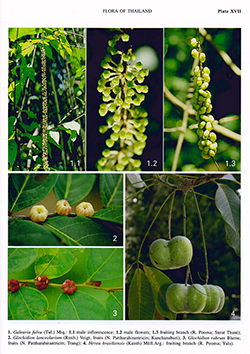e-Flora of Thailand
Volume 8 > Part 2 > Year 2007 > Page 332 > Euphorbiaceae > Hevea
Hevea brasiliensis (Kunth) Müll.Arg.
Linnaea 34: 204. 1865; in DC., Prodr. 15, 2: 718. 1866; Pax in Engl., Pflanzenr. IV. 147. i: 210; R.E. Schult., Bot. Rev. 36: 197. 1970; Econ. Bot. 41: 125. 1987; Malaysian Rubber Res. Dev. Board Mon. 14: 5. 1990; Ghani & Wessel in E. Boer & Ella, PROSEA 18 (Plants producing exudates): 73. 2001.— Siphonia brasiliensis [Willd. ex A.Juss., Euphorb. Gen. pl. 12, 38b, nom. nud.] Kunth in Humb., Bonpl. & Kunth, Nov. Gen. & Pl. 7: 171. 1825. Fig. 6; Plate XVII: 4.
Accepted Name : This is currently accepted.
Description : Tree up to 7 m high. Stipules not seen. Leaves: petiole 3–15 cm long; petiolules 5–10 mm long; leaflets elliptic, 5–21.5 by 2–7.5 cm, length/width ratio 2.5–3.1; base attenuate; apex acuminate to cuspidate; venation distinct on both sides, nerves 14–27 till apex. Inflorescences up to 31 cm long. Staminate flowers 4.5–5 mm in diam., yellowish, sweet scented; pedicel variable; calyx 5–6.2 mm long, lobes 2–4.5 by 0.5–1.5 mm; androphore 2.2–2.8 mm long, stamens 0.5–0.8 by 0.2–0.3 mm, pistillode 0.8–1 mm long. Pistillate flowers ca 5 mm in diam.; calyx ca 7 mm high, lobes ca 4.5 by 1 mm; ovary ca 2.2 by 2.2 mm; stigmas ca 0.2 mm long. Fruits ca 5 cm high. Seeds ca 2.4 by 1.9 by 1.5 cm.
Thailand : Cultivated in plantations, mainly in the South-Eastern and Peninsular. Reported 'wild' (escaped) for; SOUTH-EASTERN: Chanthaburi (Pong Nam Ron), Trat (Ko Chang); PENINSULAR: Trang (Ban Nam Phrai), Satun (Kuan Sato, Tapan Lek), Narathiwat (Waeng).
Distribution : Originally from Amazonian S America (Brazil – type), presently cultivated world-wide in the tropics.
Ecology : Reported wild and common in evergreen forests, probably because plantations have been abandoned, in fact only known from cultivation, once reported from limestone, 0–200 m alt.
Vernacular : Yang (ยาง), yang para (ยางพารา); ka-to (กะเต๊าะห์)(Malay Peninsular).
CommonName : Para rubber.
Uses: Of huge economic value. The bark is tapped for its latex by making shallow, v-shaped cuts over ⅓ of the circumference, working from ca 2 m high toward the root, moving to the next third once a row is finished. The elastic strings of polymers of cis-polyisopreen, when still unvulcanised, are easily detached from each other and they are therefore used in chewing gum (n.b. Hevea is one of the few Euphorbiaceae with a non-poisonous latex). Vulcanised (mixed with sulphur and baked) the strings become solidly attached to each other and have many applications as rubber. Natural rubber is more elastic and durable than artificial rubbers. Its main use is undoubtedly in tyres (next to condoms due to the HIV virus). The tyres are presently more and more re-used as furniture, shoes, and waste baskets in S.E. Asia and in a new kind of tarmac in Europe.
When the latex production of the fast growing trees decreases they are cut and the wood, though not durable and strong, is more and more used in Thailand for the production of beautiful, light coloured furniture, flooring, and wooden toys for children. The trees are also excellent shade trees when young; in Peninsular the shade loving Amorphophallus (Araceae) is often grown between the rows of trees for its starch rich tubers.
E-version notes : As Hevea brasiliensis (Willd. ex A.Juss.) Müll.Arg.


